Whether you’re looking for a serene fountain, a luxurious pool, or a calming pond, choosing the right backyard water feature can transform your outdoor space into a stunning oasis. However, with so many options available, selecting the perfect water feature can be a daunting task. That’s why we’re answering some of the most popular questions we get from homeowners thinking about adding a water feature to their landscape design.
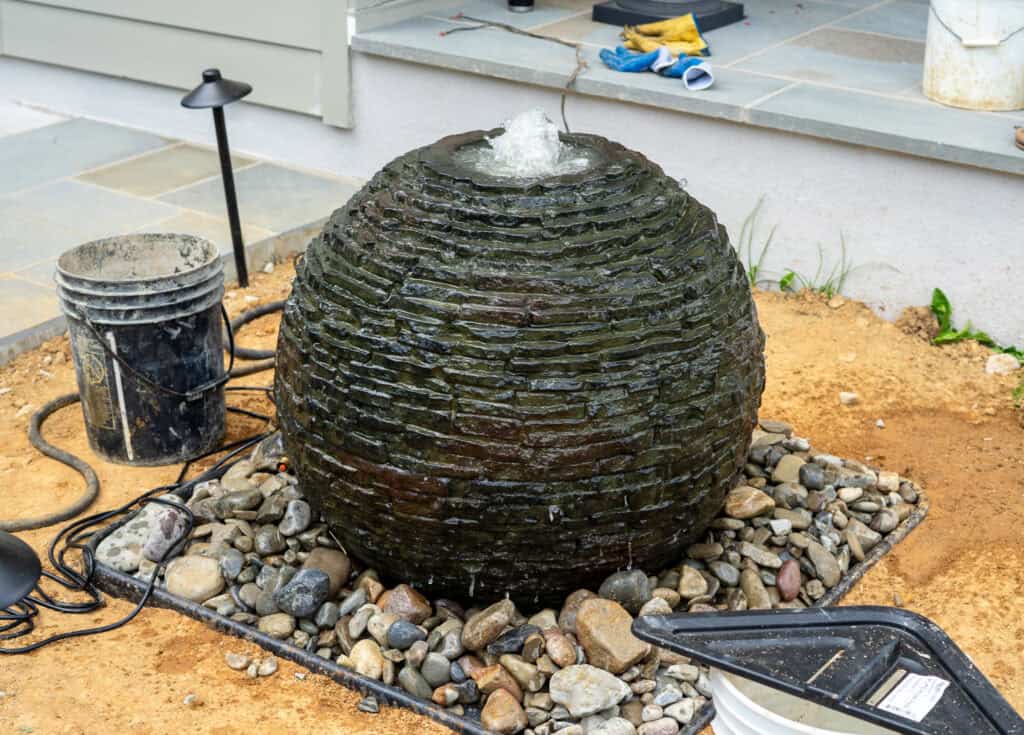
1. What Types of Backyard Water Features Can I Choose From?
There are several different types of water features that you can consider for your backyard. Here are some popular options:
-
- Ponds: Ponds are a classic water feature that can add a serene and natural element to your backyard. They can be small or large, and can include aquatic plants, fish, and even waterfalls.
- Waterfalls: Waterfalls can be standalone features or incorporated into ponds or streams. They create a soothing sound and can be a focal point in your backyard.
- Fountains: Fountains come in various sizes and styles, from small tabletop fountains to large, elaborate designs. They can be made of stone, metal, or other materials and can add a touch of elegance to your outdoor space.
- Streams: A stream can be created by connecting multiple ponds or by using a recirculating pump to create a flowing water feature. It can add movement and a sense of tranquility to your backyard.
- Water walls: Water walls are vertical water features that can be attached to a wall or freestanding. They create a visually stunning display of cascading water and can be made of glass, stone, or other materials.
- Spas or hot tubs: While not technically a water feature, spas or hot tubs can provide a relaxing and therapeutic experience in your backyard. They can be standalone or integrated into a larger water feature design.
- Water gardens: Water gardens combine aquatic plants, such as water lilies and lotus, with a small pond or container. They can be a beautiful addition to your backyard and provide a habitat for various aquatic creatures.
- Reflecting pools: Reflecting pools are shallow pools of water that create a mirror-like surface. They can be used to reflect the surrounding landscape or architectural elements, adding a sense of tranquility and beauty to your backyard.
These are just a few examples of the different types of water features you can consider for your backyard. The choice ultimately depends on your personal preferences, available space, and budget.
2. Which Water Feature Requires the Least Maintenance?
Among the different types of backyard water features, a self-contained fountain or a small pond with a recirculating pump typically requires the least maintenance. Here’s why:
-
- Self-contained fountains: These fountains are designed to recirculate water within the fountain itself, eliminating the need for a pond or additional plumbing. They usually have a small reservoir that holds the water, and a pump that continuously circulates the water through the fountain. Self-contained fountains require minimal maintenance, usually limited to occasional cleaning of the fountain components and checking the water level.
- Small ponds with recirculating pumps: If you prefer a pond-like water feature, a small pond with a recirculating pump can be a low-maintenance option. The recirculating pump keeps the water moving, which helps to prevent stagnation and maintain water quality. With proper filtration and regular maintenance of the pump and filter, such ponds can be relatively easy to maintain.
It’s important to note that while these water features require less maintenance compared to larger ponds or waterfalls, they still require some level of care. Regular cleaning, checking water levels, and maintaining the pump and filter are necessary to ensure the longevity and proper functioning of the water feature.
Ultimately, the maintenance requirements of a backyard water feature will depend on its size, complexity, and the specific components involved. It’s always a good idea to research and understand the maintenance needs of any water feature before installing it in your backyard.
3. Which Backyard Water Feature is the Easiest to Install?
The easiest backyard water feature to install would typically be a self-contained fountain. Here’s why:
Self-contained fountains: These fountains are designed to be standalone units that do not require complex plumbing or extensive construction. They usually come with a pre-built reservoir or basin, a pump, and the fountain structure. All you need to do is find a suitable location, set up the fountain, fill the reservoir with water, and plug in the pump. Some self-contained fountains may require minimal assembly, but overall, they are relatively simple to install.
Compared to other water features like ponds, waterfalls, or streams, self-contained fountains require less planning, excavation, and construction work. They can be easily placed on a patio, deck, or any level surface in your backyard. Additionally, self-contained fountains are available in various sizes and styles, allowing you to choose one that fits your space and aesthetic preferences.
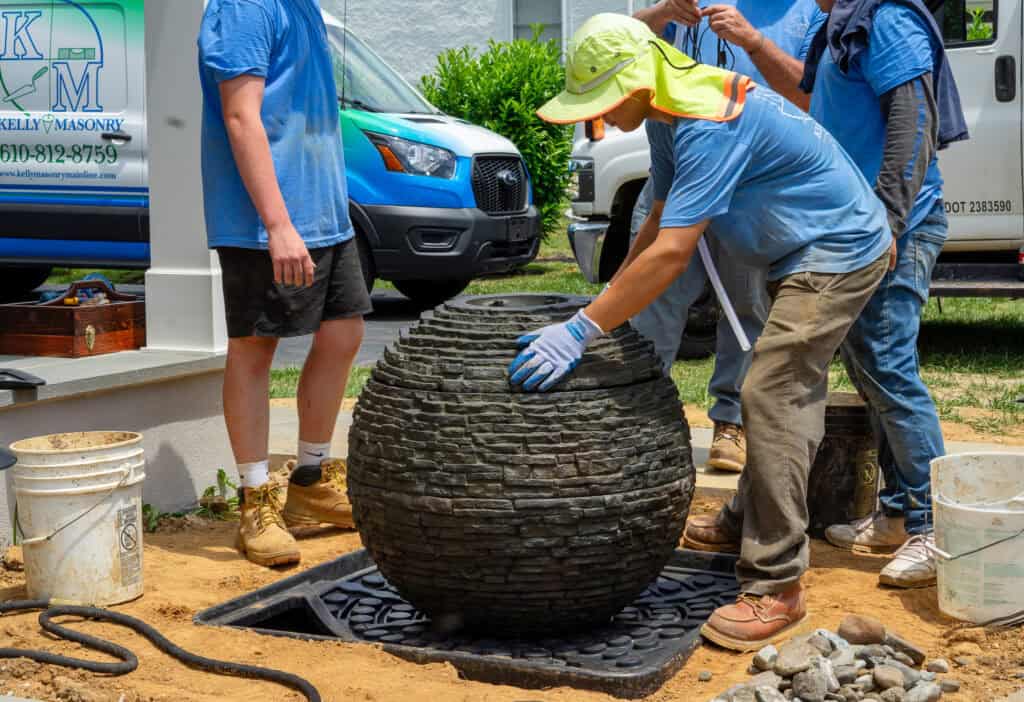
While self-contained fountains are the easiest to install, it’s still important to follow the manufacturer’s instructions and consider factors like power source availability and water supply. If you’re unsure about the installation process, it’s always a good idea to consult with a professional or refer to online resources for guidance.
4. Are there Eco-Friendly Water Features Available?
Yes, there are solar-powered options available for backyard water features. Solar-powered water features are an eco-friendly and energy-efficient alternative that can help reduce electricity consumption. Here are a few examples:
-
- Solar-powered fountains: These fountains use solar panels to harness energy from the sun and power the fountain’s pump. The solar panel is typically connected to a rechargeable battery, which stores the energy for use when the sun is not shining. Solar-powered fountains are easy to install and do not require any electrical wiring, making them a convenient option for any outdoor space.
- Solar-powered pond pumps: If you have a pond or water feature that requires a pump, you can opt for a solar-powered pond pump. These pumps use solar panels to generate electricity and power the pump, circulating the water in your pond. Solar-powered pond pumps are available in various sizes and capacities to suit different pond sizes and water flow requirements.
- Solar-powered waterfalls: Solar-powered waterfalls are designed to create a cascading water effect using solar energy. These waterfalls typically include a solar panel, pump, and tubing to circulate the water. They can be standalone features or integrated into existing ponds or water features.
Solar-powered backyard water features offer several advantages. They are environmentally friendly and eliminate the need for electrical wiring, making installation easier and more flexible. However, it’s important to consider the amount of sunlight your backyard receives and ensure that the solar panels are positioned to receive optimal sunlight for efficient operation.
When choosing a solar-powered water feature, make sure to check the specifications and capabilities of the product to ensure it meets your specific needs and preferences.
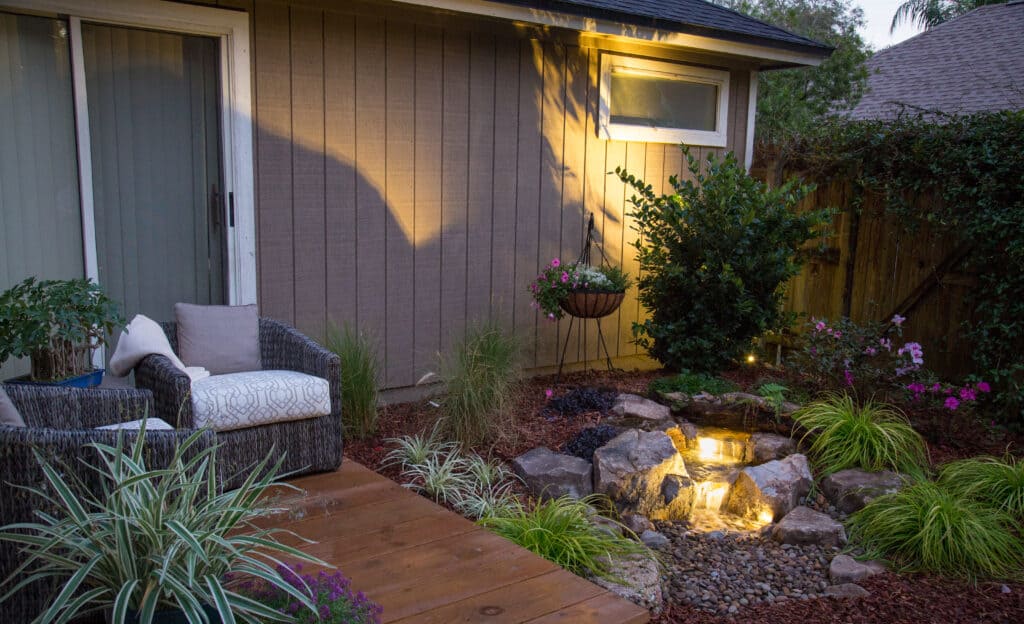
5. Where in my Backyard Should I Place a Water Feature?
The best location for a backyard water feature depends on various factors, including the size of your yard, the style of the fountain, and your personal preferences. Here are some considerations to help you determine the best location for your backyard water feature:
-
- Visibility and focal point: Choose a location where the water feature can be easily seen and appreciated. It could be a central spot in your yard, near a patio or seating area, or along a pathway. Consider placing the water feature where it can serve as a focal point and enhance the overall aesthetics of your outdoor space.
- Proximity to power source: If your backyard water feature requires electricity to operate, ensure that the chosen location is close to a power source. This will make it easier to connect the water feature to an electrical outlet without the need for long extension cords.
- Ground stability: Ensure that the ground where you plan to install the water feature is stable and level. Uneven or sloping ground may cause the water feature to tilt or become unstable. If needed, prepare the area by leveling the ground or creating a stable base for the water feature.
- Sunlight exposure: Consider the amount of sunlight the location receives throughout the day. Some backyard water feature, especially those with solar-powered pumps, require direct sunlight to operate efficiently. If your water feature relies on solar power, choose a location that receives adequate sunlight for optimal performance.
- Proximity to water source: If your water feature requires a water supply, such as a hose connection or a water line, choose a location that is easily accessible to a water source. This will make it convenient to fill or top up the water feature as needed.
- Surrounding landscape: Take into account the surrounding landscape and vegetation. Avoid placing the water feature under trees with overhanging branches, as falling leaves or debris can clog the water feature or require frequent cleaning. Additionally, consider how the water feature will complement the existing landscape design and any nearby plants or flowers.
Remember to check any local regulations or homeowner association guidelines regarding the installation of water features in your backyard. By considering these factors, you can choose the best location for your backyard water feature that enhances the overall ambiance and enjoyment of your outdoor space.
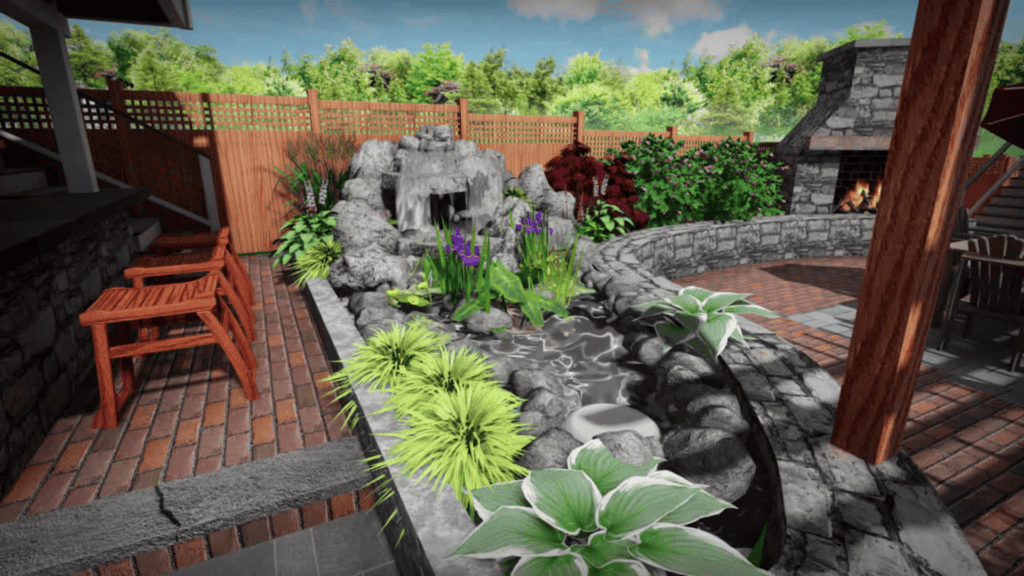
6. Can I Add a Water Feature to my Patio Design?
Yes, you can definitely add a water feature to your patio design. Incorporating a water feature into your patio or deck can enhance the overall ambiance and create a soothing and relaxing atmosphere.
When adding a water feature to your patio, consider the size of your patio, the available space, and the overall design aesthetic. Ensure that the water feature is proportionate to the patio size and doesn’t overwhelm the space. Additionally, consider factors like access to a power source and water supply, as some water features may require electricity or a water connection. If you’re thinking about hiring a landscape designer, let them know you’d like to incorporate a water feature in the design and see what they say.
By incorporating a water feature into your patio design, you can create a tranquil and inviting outdoor space for relaxation and enjoyment. To learn more, contact us for a consultation!

How to Plan a Landscape Design That Fits Your Lifestyle
Creating an outdoor space that reflects your lifestyle is more than a design challenge—it’s an opportunity to shape your daily routine, boost your home’s value,
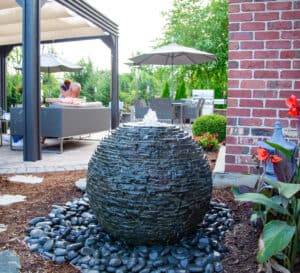
Water Feature Ideas That Elevate Curb Appeal Instantly
There’s something captivating about a water feature. The movement. The sound. The way it draws your eye and invites you closer. That’s why homeowners across

7 Issues Homeowners Face When Installing Outdoor Kitchens
Introduction: Why Outdoor Kitchens Are on the Rise — and Why Problems Happen You’ve been dreaming about it for years: warm evenings, cold drinks, friends
What Does a Masonry Contractor Do? A Complete Guide for Homeowners
Masonry has long been a pillar of strength and beauty in home construction and renovation. From classic brick facades to elegant stone patios, it’s an
Front Porch vs. Back Porch: Which Custom Design Suits Your Lifestyle?
Choosing the right type of porch for your home is more than just an aesthetic decision—it’s a lifestyle choice. Whether you’re imagining quiet evenings with

Is a Pergola Worth the Cost? Here’s What You Need to Know
You’ve been dreaming of transforming your backyard into a space that feels like an escape—somewhere cozy to relax, entertain friends, or just enjoy your morning coffee in peace. And lately, you keep seeing beautiful photos of pergolas on Pinterest and Instagram. They look stylish, inviting, and perfect for creating a little oasis right outside your door.
